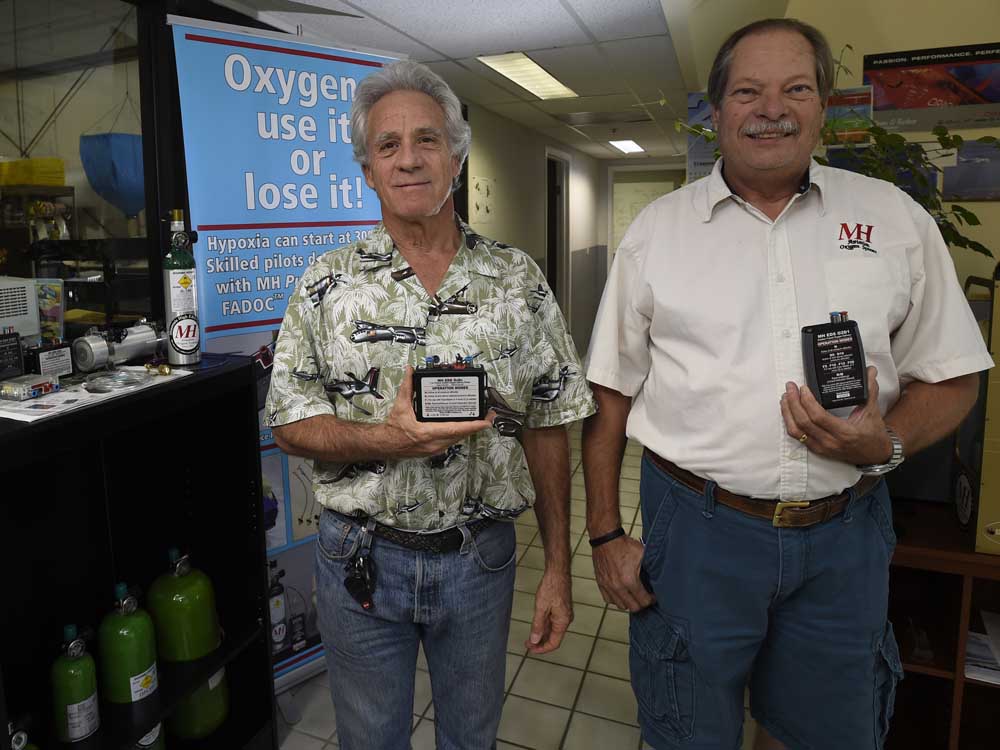Redmond company keeps pilots breathing
Published 12:00 am Tuesday, October 14, 2014

- Ryan Brennecke / The BulletinMountain High Equipment & Supply Co. founder Patrick McLaughlin, left, and Brad Stankey, general manager, with components of the Mountain High aviation oxygen system.
REDMOND —
Mountain High Equipment & Supply Co., maker of aviation oxygen systems, started in the trunk of founder Patrick McLaughlin’s car, he said recently at the company facility near Redmond Airport.
McLaughlin said he learned to fly hang gliders in Arizona, Colorado and Utah, states with some of the highest mean elevations in the U.S.
Carrying supplemental oxygen was a no-brainer, he said.
“Without oxygen a pilot gets pretty stupid, because you’re not just sitting there with a stick, you’re like a gymnast, where you’re using your body weight to generate the center of gravity,” McLaughlin said. “And that consumes a lot of oxygen, and you get pretty stupid pretty quick.”
McLaughlin means hypoxia, the condition that results when the body is deprived of an adequate supply of oxygen. Hypoxia can result in impaired judgment, dizziness and unconsciousness, among other symptoms. It can be fatal. Professional golfer Payne Stewart died in an October 1999 plane crash attributed to a probable lack of oxygen to the flight crew after the aircraft cabin depressurized at high altitude.
The Federal Aviation Administration requires air crews flying unpressurized airplanes to breath supplemental oxygen when they fly more than a half-hour above 12,500 feet and anytime above 14,000 feet. Brad Stankey, Mountain High general manager, said the company encourages pilots to use oxygen anytime starting at 8,000 feet above sea level or higher.
In his hang-gliding days in the 1980s, McLaughlin engineered a small, portable device that allowed pilots to breath supplemental oxygen when they needed it. He started out selling the device from his car, he said, to raise a little cash to fund his hang-gliding trips. By 1992, he came up with an electronic device to replace the original analog model.
“And it was wildly popular. About four months after its introduction I gave up my consulting job and now have been working for the company ever since,” he said.
The company McLaughlin founded, which now occupies the former Lancair aircraft factory, went on to supply the U.S. Army ground troops with about 4,000 supplemental oxygen units for fighting in the mountains of Afghanistan, Stankey said. The company specializes in aviation oxygen systems that pilots purchase for their own use. It also makes oxygen regulators, gauges and other parts and equipment, including transfillers, which are used to fill oxygen systems in Gulfstream jets and other aircraft.
Mountain High also met recently with Cirrus Design to discuss installing an updated oxygen system in Cirrus aircraft, McLaughlin said. The Mountain High system collects respiratory data from its users in-flight and transmits that information to the cockpit electronic instrument display.
“We’re actually using well-known respiratory physiology attributes that a good anesthesiologist would know in the ER, or a respiratory physiologist would know when he’s characterizing a patient,” McLaughlin said. “We take all that data and put it in, and now it’s to the benefit of the aviator.”
— Reporter: 541-617-7815, jditzler@bendbulletin.com
Q: How did Mountain High fare during the recession?
A: Patrick McLaughlin: We rose to the occasion to have cutting-edge technology that truly made oxygen practical, whereas in the past people had to cobble together things. … I think a lot of it is the fact that we sent a very strong message to the industry that we’re here, we’re not going to let something like this put us out of business. We manage our funds very prudently.
Q: What’s the outlook for the company in the next five years?
A: McLaughlin: We have a very strong five-year plan that’s being reworked as we speak. One good case in point is that we’ve showed the military that our box is smart enough to track the individual’s respirometrics … (And) now the traditional manufacturers of aircraft such as Cirrus Design are taking very close note of the fact that the system provides feedback to the instruments inside the aircraft as to the well-being of the pilot.






